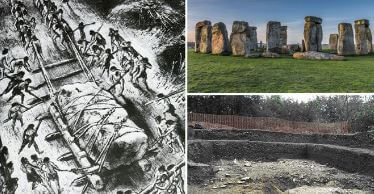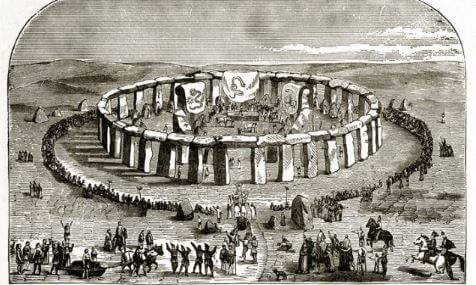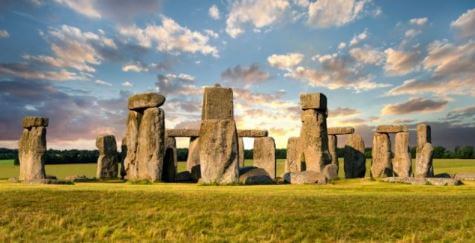
Experts believe in revealing the secrets of the builders of Stonehenge
 16. 12. 2020
16. 12. 2020

Stonehenge, one of the most remarkable places on planet Earth, is shrouded in many secrets. To this day, it is not known who actually built it. But all that may soon change thanks to new information about an ancient site in Salisbury, England.
The nearby source of Blick Mead provided evidence not only of the possible origin of this druid site, but also of indications of the first British city. Experts named it "Stonehenge Cradle" and the mystery could be solved. Archaeologists have found tools and significant elements that indicate the presence of a large community. More than 70 stone tools were found, several times more than in previous discoveries.
The first hint of the city
Dr. Albert Lin, who presented the findings in the National Geographic document over the weekend, is quoted in the Telegraph as saying that the area "was an important place for the pralids who lived and returned here, perhaps even one of the first signs of the city." .
In 2015, something was described by The Sun as a "potential Mesolithic ecological house" built on the base of a fallen tree. He goes on to say that "that huge base" could have been used as the walls of a house, and the roof was probably made of animal skins. "Add to this recent discoveries, and the likelihood of a permanent settlement is greatly increased.

The mystery of who built Stonehenge could finally be solved. Miles from the famous monument, scientists have discovered the "first British city".
If we find signs of a past life here, then it makes sense to connect them with the origin of Stonehenge. Someone had to build it! New findings could also mean that this world-famous tourist attraction is even older than previously thought.
Stonehenge
Stonehenge is thought to date back to the Mesolithic period. English Heritage writes that “the earliest buildings known in the immediate area are four or five pits, three of which were apparently reinforced by large pine totem poles. Their origin dates back to the Mesolithic period from 8500 to 7000 BC. "The site goes on to say:" It is not known how these elements relate to the later monument in Stonehenge. "

Rare and beautifully executed engraving illustration of ancient druid worship at Stonehenge, England. Engraving from the popular picture bible.
The construction of Stonehenge was not easy and, as with the Egyptian pyramids, for example, the building itself and its purpose are a source of constant fascination. History.com writes that "the erection of about a hundred boulders took an estimated 1 years for Neolithic builders." It was built over time in several phases between 500 and 3000 BC. Huge monoliths were probably transported to the site by a skid system. Archaeologists consider the place to be a burial ground, but we still have to wait for the whole story.
Blick Mead
Professor David Jacques spoke to the Telegraph about the supposed cradle of these ancient stones: “We are talking about a very small area where people have come again and again. I think it was probably a permanent settlement. ”Another possibility is that Blick Mead served as a place where vulnerable individuals, such as the sick or the elderly, could be housed.
Either way, such information can affect our view of the pralide. Professor Jacques said: "We need to revise our perceptions of the movement and life of scattered hunter-gatherer communities."
But how would such a group survive? There was obviously enough water and food. "Today, Blick Mead is a small watercourse," writes the Telegraph, "but during the Mesolithic period, it was the center of a floodplain through which a huge river flowed, providing a reliable supply of water all year round."
Food source
As for the source of food, scientists believe that they have identified the presence of a bison or other huge cattle, which have since become extinct. It is believed that hunters and gatherers were able to settle here precisely because of the rich supply of meat. "A single male of this cattle would feed 300 people," the Telegraph commented, adding that "an analysis of soil from 8-year-old Mesolithic strata shows spores from fungi that grow on cattle droppings." These ancestors were also of spiritual significance. Their skulls and bones were also recorded in Stonehenge. These remains were strategically placed in ditches.
Finding a mysterious platform in Blick Mead has led to speculation about ceremonies and rituals and provided other possible links for the above theories. The platform measures 30 feet and was detected by radar. The discovered structure has now been identified as flint. Beneath it are visible prints of the hooves of the pratur.
With so much ambiguity about ancient civilization, experts can only make qualified estimates. A place so engraved in human consciousness as Stonehenge directly calls for concrete answers. Whether this infinitely mysterious place decides to give us a question is a question that only time can show.
A gift tip for a loved one from the Sueneé Universe e-shop
Buddha bracelet made of lava stones
Bracelet with lava stones and Buddha motif. You can choose either black or turquoise.

Buddha bracelet made of lava stones







 5
5